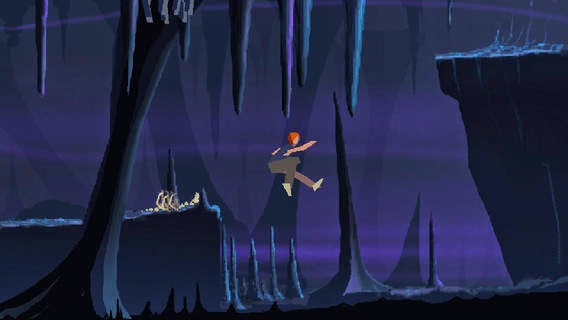Another World
When Delphine Software closed in 2004, I mourned for a week. The company was born in the late 1980s and immediately rode the wave of 16/32-bit computers that were emerging at the time—and did so with great style.
Shall we recall some of their titles? Future Wars, one of the most beautiful point-and-click adventures ever written, even though the gameplay suffered from excessive difficulty and those dreaded dead ends that were banned in later generations of this genre. Operation Stealth, another fantastic graphic adventure that I remember playing eagerly and finishing in a flash, featured a caricatured James Bond and nearly perfect gameplay, which was greatly underrated by reviews of the time.
However, the flagship game remains Another World, conceived by Éric Chahi and published in 1991 for the Amiga 500, the platform on which it was also written, and Atari ST. Due to its success, it was later ported to MS-DOS, Mega Drive, SNES, and many others.
Lester Knight Chaykin is a physicist, but the cool kind, arriving at the lab in a Ferrari, even skidding in. With some kind of DNA scan and an access password, he opens the door that leads him to his laboratory where, of course, he's working on some top-secret and extremely complex stuff.
 |
Our Lester comes to the lab in his fancy car! |
Almost by the book, the plot continues: during the countdown of the main experiment, while our hero pops open a can of Red Bull, a lightning bolt strikes the entire contraption, short-circuiting it and creating a discharge that engulfs Lester, catapulting him into another world.
The arrival in the new reality is anything but serene. Lester ends up in a lake and, with hardly any time to recover, a tentacled monster attacks him. Escaping that, he faces giant stinger-bearing worms and a cross between a saber-toothed tiger, a boar, and a sumo wrestler. After surviving all these welcome misfortunes, he ends up in the hands of the rulers of this world: a humanoid race with some intellect, but not too much, who respond to Lester's gesture of greeting with a good whack to the gums, knocking him out and locking him up in a cage with other slaves of the local race. The player, who had taken over the reins when we were in the lake with the giant octopus, must guide Lester through countless dangers in an attempt to escape captivity.
 |
Lester in a cage along with an alien roommate. |
.png) |
Lester tries to figure out how to take out the hooked worms, while a friendly big cat watches him in the distance. |
 |
The puzzles were a perfect mix of clever use of the weapon, also used to interact with the environment, and labyrinthine levels. |
 |
The alien on the right is one frame away from a bad end... |
 |
Here is a typical firefight with the respective barriers of energy created by these special guns. |
Setting aside Heart of the Alien, a sort of official sequel to the game available only for Sega Mega CD, whose protagonist is the alien co-star of Another World, other games considered sequels to this masterpiece were Flashback and Fade to Black, but only because they were published by Delphine Software in the years following Another World and partly took up the gameplay, as the story was separate and had nothing to do with our Lester. I remember perfectly that the rumors of Flashback's release described it as the sequel, triggering the frenzy of those who really loved this game. In the end, Flashback also turned out to be a very enjoyable product, but it had lost something compared to the pathos of its predecessor.
Éric Chahi: The Visionary Behind the Visuals
Before gaining fame for the critically acclaimed Another World, Éric Chahi lent his talents to Future Wars as a background artist. His distinct artistic vision is evident in the game's stunning environments, which push the technical limits of the 16-bit Amiga and Atari ST, as well as the PC MS-DOS.
Chahi's intricate and atmospheric backgrounds helped immerse players in the game's sci-fi world, creating a cinematic feel that was ahead of its time. His later work on Another World would solidify his reputation as a master of blending visuals and storytelling, but his contributions to Future Wars remain a testament to his early genius in the gaming industry.
The Verdict
A true classic. If you've never tried it and want to play some vintage, hurry up and fire up the emulator, or ask your uncle for an Amiga 500, or if you just can't manage that, shoot for one of the recent ports for iOS, Android, PlayStation 3, 4, and Vita, Xbox One, Nintendo Wii U, Nintendo 3DS... We're talking about something that belongs in the Olympus of the best games ever written.
Pros
- ✔ Extremely high playability: Immediate controls despite the game's good complexity.
- ✔ Beautiful story: Brilliantly told without the use of dialogue, showcasing innovative narrative techniques.
Cons
- ✘ Short length: The game is very short and leaves a slight sense of incompleteness.
- ✘ Lack of a true sequel: Fans were left waiting for a continuation that sadly never materialized.
| Score | Rating |
|---|---|
| Amiga 500 Game | 98% |




Comments
Post a Comment